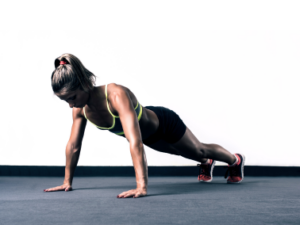Can Strength Training Help with Weight Loss?
Absolutely. While many people associate strength training solely with muscle building, it’s actually one of the most effective methods for sustainable weight loss. Strength training not only helps build lean muscle mass but also boosts your metabolism, aids in fat loss, and supports overall body transformation. Unlike high-impact cardio, which can be hard on the joints, strength training offers a lower-impact way to lose weight, making it an ideal choice for those with joint pain or anyone looking for a sustainable approach to weight management.
In this article, we’ll break down how strength training contributes to weight loss, the science behind it, and share strategies and beginner routines to help you reach your weight loss goals.
How Does Strength Training Contribute to Weight Loss?
Many people believe cardio is the only way to lose weight. However, strength training is just as effective—if not more so—especially when combined with a healthy diet. Strength training creates a “caloric afterburn” effect known as EPOC (Excess Post-exercise Oxygen Consumption), meaning your body continues to burn calories for hours after you’ve finished working out. Additionally, by building lean muscle, your body burns more calories at rest, making it easier to maintain a caloric deficit, which is key to weight loss.
Fat Loss vs. Weight Loss: Why Strength Training Focuses on Fat Loss
When talking about weight loss, it’s crucial to distinguish between losing weight and losing fat. Fat loss is often the healthier and more sustainable approach, as it preserves muscle mass, which is vital for a toned, lean appearance. Strength training supports fat loss by promoting muscle gain, so you’re focusing on body composition changes rather than just the number on the scale. Through strength training, you’ll aim to lose fat, improve muscle definition, and achieve long-term fitness and health goals.
How to Create A Strength Training Program for Weight Loss
There are a lot of great strength training exercises for beginners to use when starting out. Pushups, squats, deadlifts, and resistance band exercises are all extremely effective and can be performed at home. These movements are also great because they target more than one muscle group, something that is optimal for burning fat.
When you start getting more and more experienced with whatever strength building exercises you choose, continue to add repetitions as the workouts become easier. This is called progressive overload, and is essential for fat loss.
A sample beginner’s strength training workout might look something like:
Warm-Up (5-10 Minutes)
- Jumping Jacks – 1 minute
- Arm Circles – 30 seconds forward, 30 seconds backward
- Bodyweight Squats – 15 reps (warm-up only)
- Walking Lunges – 10 reps per leg
Workout
1. Bodyweight Squats

- Reps: 12-15
- Sets: 3
- Rest: 30-45 seconds between sets
- Form Tips: Keep your chest up, engage your core, and push through your heels.
2. Push-Ups (Modified if Needed)

- Reps: 10-12
- Sets: 3
- Rest: 30-45 seconds between sets
- Form Tips: For beginners, start with push-ups on your knees or against a wall.
3. Dumbbell Rows (Single Arm)

- Reps: 10-12 per arm
- Sets: 3
- Rest: 30-45 seconds between sets
- Form Tips: Focus on pulling with your back and squeezing your shoulder blades.
4. Glute Bridges

- Reps: 15-20
- Sets: 3
- Rest: 30-45 seconds between sets
- Form Tips: Keep your core tight and press through your heels for maximum glute engagement.
5. Standing Dumbbell Shoulder Press

- Reps: 10-12
- Sets: 3
- Rest: 30-45 seconds between sets
- Form Tips: Start with light weights and press straight up without locking out your elbows.
6. Plank

- Duration: 20-30 seconds
- Sets: 3
- Rest: 30 seconds between sets
- Form Tips: Keep your body in a straight line, avoiding sagging or raising your hips.
Cool-Down and Stretching (5-10 Minutes)
- Child’s Pose – 30 seconds
- Hamstring Stretch – 30 seconds per leg
- Shoulder Stretch – 30 seconds per arm
- Cat-Cow Stretch – 1 minute
Recovery, Nutrition, & Long Term Benefits
Recovery from exercise is just as important as the workouts themselves. Rest days are essential for muscle repair, and if you don’t give your body time to recover you increase your chances of getting injured and having to take the time to recover, which will decrease all the gains you’ve made while training. Using proper form and gradually increasing intensity over a long period of time is the best way to ensure that you’re progressing and also staying healthy.
Nutrition while strength training for fat loss is essential to reach your goals. Make sure you’re watching how many calories you’re eating during the day vs how much you’re burning during exercise. Staying hydrated is also extremely important, as you want your body to be as well fueled as possible.
When you start seeing results from strength training, it can be addicting. Not only will your body change, but you’ll sleep better, have more energy, and potentially see an increase in your mental health. People who stick to their routine and really dedicate themselves to strength training tend to feel stronger and more confident in their lives.
Burn Fat & Get Strong at Physiq Fitness
If you’re looking to lose some weight with strength training, and you live in Salem, Keizer, Albany, or Lancaster, Oregon, Physiq Fitness has you covered. Our gyms are filled with all of the equipment you need to burn some fat and reach your goals. If you’re more of a group fitness person, you can take advantage of our QFIT Team Training program, which is a cutting-edge small-group fitness program that offers five different styles of HIIT classes. We also offer many larger group fitness classes to ensure beginners have a place to learn proper form.
Learn more about QFIT Team Training and our membership options today! With five convenient locations in the Salem area, we’d love to help you on your way to a happier, healthier lifestyle. If you have any questions, please feel free to reach out and ask!

